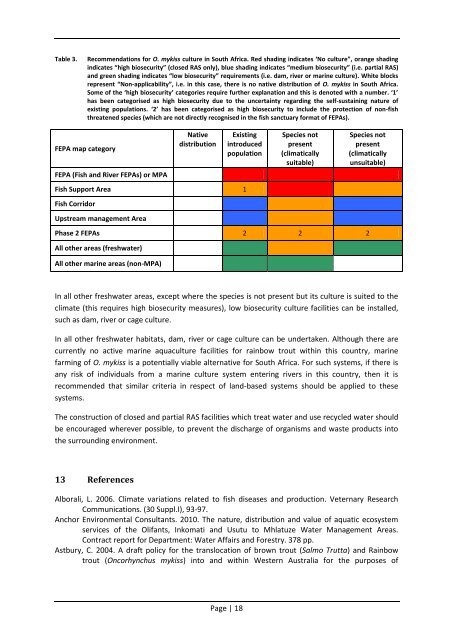Table 3.Recommendations for O. <strong>mykiss</strong> culture in South Africa. Red shading indicates ‘No culture”, orange shadingindicates “high biosecurity” (closed RAS only), blue shading indicates “medium biosecurity” (i.e. partial RAS)and green shading indicates “low biosecurity” requirements (i.e. dam, river or marine culture). White blocksrepresent “Non-applicability”, i.e. in this case, there is no native distribution <strong>of</strong> O. <strong>mykiss</strong> in South Africa.Some <strong>of</strong> the ‘high biosecurity’ categories require further explanation and this is denoted with a number. ‘1’has been categorised as high biosecurity due to the uncertainty regarding the self-sustaining nature <strong>of</strong>existing populations. ‘2’ has been categorised as high biosecurity to include the protection <strong>of</strong> non-fishthreatened species (which are not directly recognised in the fish sanctuary format <strong>of</strong> FEPAs).FEPA map categoryNativedistributionExistingintroducedpopulationSpecies notpresent(climaticallysuitable)Species notpresent(climaticallyunsuitable)FEPA (Fish and River FEPAs) or MPA 1 1 1Fish Support Area 1 1Fish CorridorUpstream management AreaPhase 2 FEPAs 2 2 2All other areas (freshwater)All other marine areas (non-MPA)In all other freshwater areas, except where the species is not present but its culture is suited to theclimate (this requires high biosecurity measures), low biosecurity culture facilities can be installed,such as dam, river or cage culture.In all other freshwater habitats, dam, river or cage culture can be undertaken. Although there arecurrently no active marine aquaculture facilities for rainbow trout within this country, marinefarming <strong>of</strong> O. <strong>mykiss</strong> is a potentially viable alternative for South Africa. For such systems, if there isany risk <strong>of</strong> individuals from a marine culture system entering rivers in this country, then it isrecommended that similar criteria in respect <strong>of</strong> land-based systems should be applied to thesesystems.The construction <strong>of</strong> closed and partial RAS facilities which treat water and use recycled water shouldbe encouraged wherever possible, to prevent the discharge <strong>of</strong> organisms and waste products intothe surrounding environment.13 ReferencesAlborali, L. 2006. Climate variations related to fish diseases and production. Veternary ResearchCommunications. (30 Suppl.I), 93-97.Anchor Environmental Consultants. 2010. The nature, distribution and value <strong>of</strong> aquatic ecosystemservices <strong>of</strong> the Olifants, Inkomati and Usutu to Mhlatuze Water Management Areas.Contract report for <strong>Department</strong>: Water Affairs and Forestry. 378 pp.Astbury, C. 2004. A draft policy for the translocation <strong>of</strong> brown trout (Salmo Trutta) and <strong>Rainbow</strong>trout (<strong>Oncorhynchus</strong> <strong>mykiss</strong>) into and within Western Australia for the purposes <strong>of</strong>Page | 18
ecreational stocking, domestic stocking, commercial and non-commercial aquaculture.FISHERIES MANAGEMENT PAPER NO. 179 <strong>Department</strong> <strong>of</strong> Fisheries, Australia. 50 pp.Bainbridge, W., Alletson, D., Davies, M., Lax, I. & Mills, J. 2005. The Policy <strong>of</strong> FOSAF on the Presence<strong>of</strong> <strong>Trout</strong> in the Freshwater Aquatic Systems <strong>of</strong> South and Southern Africa : Position PaperNo. 3. Environmental Commitee, Federation <strong>of</strong> Southern African Flyfishers. Unpublishedreport, FOSAF Secretariat, Johannesburg. 17 pp.Bartley, D. & C.V. Casal, 1998. Impacts <strong>of</strong> introductions on the conservation and sustainable use <strong>of</strong>aquatic biodiversity. FAN Aquaculture Newsletter 20: 15–19.Bekker, A., Hugo, C., Albertyn, J., Boucher, C. E. and Bragg, R. R. (2011), Pathogenic Gram-positivecocci in South African rainbow trout, <strong>Oncorhynchus</strong> <strong>mykiss</strong> (Walbaum). Journal <strong>of</strong> FishDiseases, 34: 483–487.Britz, P.J., Lee, B. & Botes, L. 2009. AISA 2009 Aquaculture Benchmarking Survey: Primary Productionand Markets. AISA report produced by Enviro-Fish Africa (Pty) Ltd. 117p.Candiotto, A., Bo, T. & Fenoglio, S. 2011. Biological and ecological data on an established rainbowtrout (<strong>Oncorhynchus</strong> <strong>mykiss</strong>) population in an Italian stream. Fundamentals <strong>of</strong> AppliedLimnology 179: 67–76.Cambray, J.A. 2003a. The global impact <strong>of</strong> alien trout species — a review; with reference to theirimpact in South Africa. African Journal <strong>of</strong> Aquatic Science 28: 61-67.Cambray, J.A. 2003b. Impact on indigenous species biodiversity caused by the globalization <strong>of</strong> alienrecreational freshwater fisheries. Hydrobiologia 500: 217–230.Cambray, J.A. & Pister, E.P. 2002. The role <strong>of</strong> scientists in creating public awareness for theconservation <strong>of</strong> fish species: African and American case studies. In: M.J. Collares-Pereira, I.G.Cowx & Coelho M.M. (eds) conservation <strong>of</strong> Freshwater Fishes: Options for the Future.Oxford: Fishing News Books, Blackwell Science, pp. 414–423.Clark, B. & Ratcliffe, G. (eds) 2007. Berg River Baseline Monitoring Programme: Final Report–Volume5: Synthesis. Publication No P WMA 19/G10/00/2107. Pretoria: <strong>Department</strong> <strong>of</strong> WaterAffairs.Copp, G.H., Britton, J.R., Cowx, I.G., Jeney, G., Joly, J-P., Gherardi, F., Gollasch, S., Gozlan, R.E., Jones,G., MacLeod, A., Midtlyng, P.J., Miossec, L., Nunn, A.D., Occhipinti-Ambrogi, A., Oidtmann,B., Olenin, S., Peeler, E., Russell, I.C., Savini, D., Tricarico, E. & Thrush, M. 2008. Riskassessment protocols and decision making tools for use <strong>of</strong> alien species in aquaculture andstock enhancement. EU Co-ordination Action Project: IMPASSE Environmental impacts <strong>of</strong>alien species in aquaculture, Deliverable report 3.2.DAFF 2012a. <strong>Department</strong> <strong>of</strong> <strong>Agriculture</strong>, Forestry and Fisheries. South Africa’s Auaculture AnnualReport 2011.DAFF 2012b. <strong>Department</strong> <strong>of</strong> <strong>Agriculture</strong>, Forestry and Fisheries. Animal Disease Status <strong>of</strong> SouthAfrica (24 February 2012).Driver, A., Nel, J.L., Snaddon, K., Murray, K., Roux, D., Hill, L., Swartz, E.R., Manuel, J. & Funke, N.2011. Implementation Manual for Freshwater Ecosystem Priority Areas. WRC Report No.1801/1/11. ISBN 978-1-4312-0147-1. Pretoria.Du Preez, M. & Lee, D.E. 2010. The contribution <strong>of</strong> trout fly fishing to the economy <strong>of</strong> Rhodes, NorthEastern Cape, South Africa. Development Southern Africa 27: 241-253.Duncan, W.M. 1991. The interactions between feral rainbow trout and the indigenous salmonids inLoch Awe, Scotland. Ph.D. thesis, University <strong>of</strong> Sterling, Sterling, United Kingdom.Engelbrecht, J. & Bills, R. 2007. Barbus treurensis. In: IUCN 2012. IUCN Red List <strong>of</strong> ThreatenedSpecies. Version 2012.1. . Downloaded on 03 September 2012.Page | 19
















